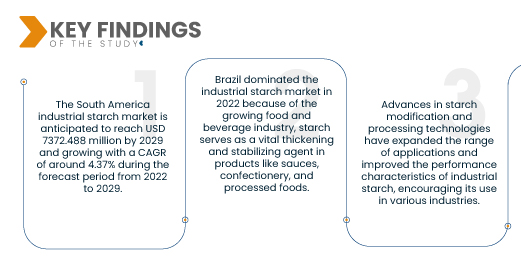Industrial starch, derived from various sources like corn, potato, or tapioca, is a versatile ingredient with numerous features, advantages, and uses. Its remarkable thickening and binding properties make it a key component in food processing, pharmaceuticals, and personal care products. Additionally, industrial starch is biodegradable and renewable, aligning with sustainability efforts. Its widespread adoption benefits various industries, enhancing product texture, stability, and performance while contributing to eco-friendly practices, and reducing environmental impact.
Access Full Report at https://databridgemarketresearch.com/reports/south-america-industrial-starch-market
Data Bridge Market Research analyses that the South America Industrial Starch Market accounted for USD 5,236.10 million in 2021 and is expected to reach USD 7,372.488 million by 2029. The market is registering a CAGR of 4.37% during the forecast period of 2022 to 2029. Government regulations advocating for the use of biodegradable and renewable materials have incentivized industries to incorporate industrial starch in various applications. With its eco-friendly properties, industrial starch aligns with sustainability goals, reducing environmental impact and encouraging its adoption as a viable alternative to synthetic materials.
Key Findings of the Study
Shift toward natural and renewable ingredients is expected to drive the market's growth rate
As sustainability becomes a South America priority, industries are increasingly adopting eco-friendly practices and seeking natural and renewable alternatives for their processes. Starch, derived from sources like corn, potatoes, and tapioca, has gained prominence as a versatile and renewable ingredient. Its biodegradability, abundance, and renewability make it an attractive choice in various industrial applications, such as food, paper, packaging, pharmaceuticals, and personal care. This trend towards utilizing starch aligns with the broader commitment to reducing environmental impact and promoting a greener and more sustainable future.
Report Scope and Market Segmentation
|
Report Metric
|
Details
|
|
Forecast Period
|
2022 to 2029
|
|
Base Year
|
2021
|
|
Historic Years
|
2020 (Customizable to 2014-2019)
|
|
Segments Covered
|
Type (Native Starch and Starch Derivatives and Sweeteners, Cationic Starch, Ethylated Starch, Oxidized Starch, Acid Modified Starch and Unmodified Starch) Source (Corn, Wheat, Cassava, Potato, and Other Sources), Application (Food and Beverage, Feed and Other Applications), Form (Dry Form and Liquid), Function (Stabilizing, Thickening, Film Forming Agents, Gelling Agent, Texturizing, Binding, Emulsifying, Sizing, Moisture Retention and Coating)
|
|
Countries Covered
|
Brazil, Argentina and Rest of South America as part of South America.
|
|
Market Players Covered
|
Roquette Frères (U.S.), Meelunie B.V. (U.S.), Tate & Lyle (U.K.), Sudzucker Group (U.S.), Molinos Juan Semino SA (U.S.), ARGANA Beteiligungs-AG (U.S.), ADM (U.S.), Cargill, Incorporated (U.S.), Tereos S.A (U.K.), Ingredion (U.S.)
|
|
Data Points Covered in the Report
|
In addition to the insights on market scenarios such as market value, growth rate, segmentation, geographical coverage, and major players, the market reports curated by the Data Bridge Market Research also include depth expert analysis, patient epidemiology, pipeline analysis, pricing analysis, and regulatory framework
|
Segment Analysis:
The South America industrial starch market is segmented on the basis of type, source, form, application and function.
- On the basis of type, the South America industrial starch market is segmented into native starch and starch derivatives and sweeteners, cationic starch, ethylated starch, oxidized starch, acid modified starch, and unmodified starch.
- On the basis of source, the South America industrial starch market is segmented into corn, wheat, cassava, potato, and other sources.
- On the basis of application, the South America industrial starch market is classified into food and beverage, feed, and other applications.
- On the basis of form, the South America industrial starch market is segmented into dry form and liquid.
- On the basis of function, the South America industrial starch market is segmented into stabilizing, thickening, film forming agents, gelling agent, texturizing, binding, emulsifying, sizing, moisture retention, and coating.
Major Players
Data Bridge Market Research recognizes the following companies as the major South America Industrial starch market players in Industrial starch market are Roquette Frères (U.S.), Meelunie B.V. (U.S.), Tate & Lyle (U.K.), Sudzucker Group (U.S.), Molinos Juan Semino SA (U.S.), ARGANA Beteiligungs-AG (U.S.), ADM (U.S.), Cargill, Incorporated (U.S.), Tereos S.A (U.K.), Ingredion (U.S.)
Market Developments
- In November 2021, Ingredion introduced FILMKOTE 2030, a sustainable barrier starch, targeting food service packaging in the United States and Canada. This innovative product offers excellent oil and grease resistance, providing manufacturers with a viable alternative to replace fluorochemicals with an eco-friendly option.
- In April 2021, Cargill Inc. disclosed its intention to broaden its specialty tapioca starch offerings in the Asia Pacific market. Collaborating with Starpro, a reputable food-grade tapioca starch producer in Thailand, Cargill aims to expand its presence in the region.
- In January 2021, Tate & Lyle, a renowned South America supplier of food and beverage solutions and ingredients, recently unveiled the expansion of its tapioca-based starch offerings. The expansion encompasses the introduction of novel REZISTA MAX thickening starches and BRIOGEL gelling starches to their product line.
Regional Analysis
Geographically, the countries covered in the South America industrial starch market report are Brazil, Argentina, and Rest of South America as part of South America.
As per Data Bridge Market Research analysis:
Brazil is the dominant region in South America industrial starch market during the forecast period 2022 - 2029
In 2022, Brazil dominated the industrial starch market as starch plays a crucial role as a thickening and stabilizing agent in sauces, confectionery, and processed foods. Additionally, the paper and packaging sector has expanded, driving the demand for starch as a binding and coating agent. Furthermore, the pharmaceutical and personal care industries have adopted starch for tablet binding and cosmetic product formulation. This increasing usage demonstrates the region's acknowledgment of starch's versatile benefits and cost-effectiveness across multiple applications.
For more detailed information about the industrial starch market report, click here – https://www.databridgemarketresearch.com/jp/reports/south-america-industrial-starch-market














